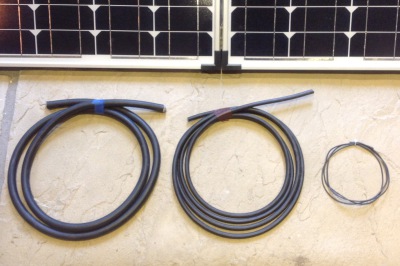Cable Sizing
So you've assembled the parts for a renewable energy project, you've got you're method of generation, you've got your storage (possibly) and you've got various bits of electrical kit between the source of electrical power and the point of use.
You've got to join them all up somehow!
The conventional method is to connect them using copper cables of a thickness depending on the power to be transmitted. To help with the principal behind this, think of electrical current as a flow of water. You can get a greater flow of water from a large pipe than a small pipe, and the same is true of electrical cable and electrical current.
The other two concepts to get to grips with are power and volt drop. Put simply power in 'Watts' can be calculated by multiplying the current in 'Amps' by the voltage in 'Volts'. For a very low voltage DC system it would be as follows:
12v x 10A = 120W
The voltage drop is dependent on the length of the cable (and a few other factors beyond our scope here today) simply put it is calculated as (volt drop per meter x length x current)
Back to the script - as it were, let's size a cable!
For our 120W load we know that we need a cable that will take 10A. We should always add a safety margin of 10% so our figure is 11A. All you need to do, is either look at the tables in BS7671 or cable manufacturers data to find the current that your chosen cable can handle.
1mm cross sectional area cable has a current carrying capacity of 14.5 A (multicore insulated, non armoured, copper conductor) so theoretically we could use this.
But what about volt drop?
Obviously we would like the voltage at the end of the wire to be a close as possible to the voltage that we started out with!
From the same set of tables we can find the volt drop for this particular cable is 46mV(mV = millivolts) per Amp per meter. Lets say that we have a 20m run...
20 x 10A x 46 = 9,200 But WAIT!!!!!!
Remember the volt drop figure is in millivolts so we now divide 9,200 by 1,000 to get Volts
Our voltage drop is 9.2V meaning that you start off with 12V and end up with 2.8V!
We now have two options, raise the voltage but lower the current (This keeps the power the same)
600V x 0.2A = 120W
Or get a bigger cable, but what size should it be?
Back to the tables....
50mm multicore copper cable has a volt drop of 0.98mV per meter per Amp
20 x 10A x 0.98 = 196
196/1000 = 0.196V
Using 50mm cable we start with 12V and we end up with 11.804V
Just to put that in perspective the cable is now 50 times larger than we started with, the moral of the story is keep the voltage as high as you can, and the distances as low as possible to minimise losses in the cable.














